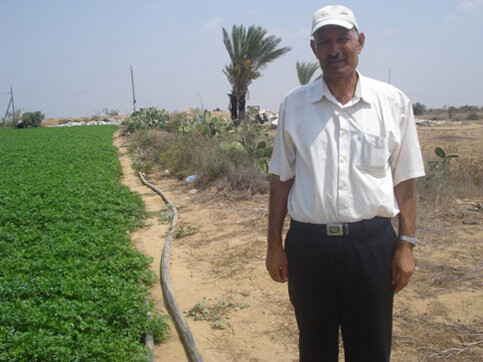Palestinian Center for Human Rights 28 August 2008

Abu Jihad Shaheen can only farm 20 dunams of his 86 dunams of farmland in the Gaza Strip, because of continued Israeli intimidation towards farmers living near the border with Israel. (PCHR)
New Abasan village in South Eastern Gaza looks, and feels, almost haunted. Every third or fourth house is a mound of rubble, or else has been partially destroyed, and the village streets are dusty and devoid of life. Many local Palestinians have been driven out of New Abasan by relentless Israeli incursions into the village. The Israeli occupation forces (IOF) have bulldozed huge tracts of land in and around New Abasan, and demolished dozens of local houses.
Beyond the village itself are hundred more dunams of rich agricultural farmland (a dunam is the equivalent of 1,000 square meters) lying near Gaza’s eastern border with Israel. Abu Jihad Shaheen is a local farmer who owns a farm about a kilometer outside New Abasan village near the border with Israel. Abu Jihad used to live on his farm with his family, but after years of Israeli invasions of his land, he was finally forced to leave when the IOF demolished his water well earlier this year. After he and his family left the farm the IOF destroyed their farmhouse.
Now Abu Jihad and his family live in New Abasan village. “My brother, Yousef, and I own our farm together,” he says, as we stand at the beginning of his land, gazing towards the border. “We own 86 dunams of land, but we can only farm the 20 dunams furthest from the border — it is too dangerous for us to work on the rest of our land.”
Twenty dunams of fresh parsley surround us, ripe for hand-picking, but beyond that stretch another 66 dunams of dry yellow earth leading right up to the border. We walk to the far end of the parsley fields where we are standing 450 meters from the border with Israel, and Abu Jihad will go no further. When he points out the ruin of his house just a couple of hundred meters ahead, there are tears in his eyes. “Yousef and I have lost more than $300,000 because we can’t farm our land any more” he says. “We had almond, olive and citrus trees, and we exported fruit and vegetables to the West Bank and Jordan, and to Israel. Now we will be lucky to make $300 from selling the parsley.”
The most striking thing about the expanse of farmland along the southeastern Gaza border is the almost total absence of people: apart from Abu Jihad, his brother, Yousef and a local farm-worker who’s come to help them pick the parsley, there is no-one to be seen. The Shaheen brothers, who now have to pipe water from a nearby house to their parsley fields, say dozens of local farming families have been driven from the area, leaving fields and farmhouses empty. Abu Jihad says the tahdia or “period of calm” that came into force on 19 June has made no difference to his access to his own land. “I still cannot farm my land” he says. His brother agrees. “They [the Israelis] still open fire every day” says Yousef. “They fire warning shots into the air, and we see drones and helicopters circling in the sky above us. We do not feel safe here on our land.”
At the beginning of the second intifada, in September 2000, a 150 meter buffer zone was established either side of the Gaza-Israel border. Over the last few years the IOF have unilaterally extended the buffer zone to more than 300 meters, while at the same time continuing to deliberately destroy thousands of dunams of Gazan farmland, including farmland way beyond the buffer zone. A 400 meter buffer zone around the border of the Gaza represents a net loss of at least 20 square kilometers of fertile farmland. But this year alone, 3,400 dunams of farmland inside Gaza have been bulldozed by IOF, the vast majority of it along the south eastern border, including farms that stood 2.5 kilometers from the border with Israel.
The deliberate destruction of civilian property is illegal under international human rights and humanitarian law, including the Fourth Geneva Convention (articles 33 and 53). Although the IOF has stopped bulldozing Gazan farmland since 19 June, many farmers living near the border remain frightened of returning to their own land.
Abu Jihad takes us to meet another local farmer. Yunis Khalil Abu Latifa is 56, and owns fifty dunams of local land. We sit under the olive trees outside his house, and eat fresh, sweet figs from his garden. “I had ten dunams of fruit trees just behind my house” he tells us, “but the Israelis bulldozed them. Our land is fertile, but we cannot farm here anymore.” Regarding the tahdia, Abu Latifa says he thinks it has made some difference. “My family feels more personally secure in this area now that they [the Israelis] are not shooting and invading [our area] every day” he says. “But I still can’t work on my land”
One week before the tahdia started, an IOF rocket struck Abu Latifa’s house. No-one was injured, but the family home was badly damaged. Abu Latifa is adamant no rockets had been fired by Palestinians. “We are all farmers here” he says, “and we just want to farm.” He suddenly gestures in the direction of the border. “I have forty dunams of good land up there” he says. “It is just 800 meters away, and I could walk there in ten minutes. But if anyone goes onto their land [near the border] they will be shot, even now. I haven’t been able to farm those 40 dunams for more than four years.”
This report is part of the Palestinian Centre for Human Rights’ Narratives Under Siege series.